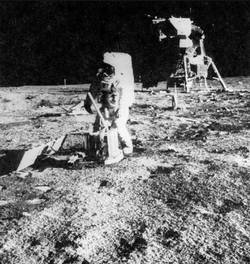15 Key Milestones Compiled From Kinescopes, Videotape, And NASA
Telemetry
 NASA has released newly
restored video from the July 20, 1969, live television broadcast of
the Apollo 11 moonwalk. The release commemorates the 40th
anniversary of the first mission to land astronauts on the
moon.
NASA has released newly
restored video from the July 20, 1969, live television broadcast of
the Apollo 11 moonwalk. The release commemorates the 40th
anniversary of the first mission to land astronauts on the
moon.
The initial video release, part of a larger Apollo 11 moonwalk
restoration project, features 15 key moments from the historic
lunar excursion of Neil Armstrong and Buzz Aldrin.
A team of Apollo-era engineers who helped produce the 1969 live
broadcast of the moonwalk acquired the best of the broadcast-format
video from a variety of sources for the restoration effort. These
included a copy of a tape recorded at NASA's Sydney, Australia,
video switching center, where down-linked television from Parkes
and Honeysuckle Creek was received for transmission to the U.S.;
original broadcast tapes from the CBS News Archive recorded via
direct microwave and landline feeds from NASA's Johnson Space
Center in Houston; and kinescopes found in film vaults at Johnson
that had not been viewed for 36 years.
"The restoration is ongoing and may produce even better video,"
said Richard Nafzger, an engineer at NASA's Goddard Space Flight
Center in Greenbelt, Md., who oversaw television processing at the
ground tracking sites during Apollo 11. "The restoration project is
scheduled to be completed in September and will provide the public,
future historians, and the National Archives with the highest
quality video of this historic event."

File Photo
NASA contracted with Lowry Digital of Burbank, Calif., which
specializes in restoring aging Hollywood films and video, to take
the highest quality video available from these recordings, select
the best for digitization, and significantly enhance the video
using the company's proprietary software technology and other
restoration techniques.
Under the initial effort, Lowry restored 15 scenes representing
the most significant moments of the three and a half hours that
Armstrong and Aldrin spent on the lunar surface. NASA released the
video Thursday at a news conference at the Newseum in
Washington.
On July 20, 1969, as Armstrong made the short step off the
ladder of the Lunar Excursion Module onto the powdery lunar
surface, a global community of hundreds of millions of people
witnessed one of humankind's most remarkable achievements live on
television.
The black and white images of Armstrong and Aldrin bounding
around the moon were provided by a single small video camera aboard
the lunar module. The camera used a non-standard scan format that
commercial television could not broadcast.
NASA used a scan converter to optically and electronically adapt
these images to a standard U.S. broadcast TV signal. The tracking
stations converted the signals and transmitted them using microwave
links, Intelsat communications satellites, and AT&T analog
landlines to Mission Control in Houston. By the time the images
appeared on international television, they were substantially
degraded.

File Photo
At tracking stations in Australia and the United States,
engineers recorded data beamed to Earth from the lunar module onto
one-inch telemetry tapes. The tapes were recorded as a backup if
the live transmission failed or if the Apollo Project needed the
data later. Each tape contained 14 tracks of data, including
bio-medical, voice, and other information; one channel was reserved
for video.
A three-year search for these original telemetry tapes was
unsuccessful. A final report on the investigation is expected to be
completed in the near future and will be publicly released at that
time.
 ANN's Daily Aero-Linx (04.16.24)
ANN's Daily Aero-Linx (04.16.24) Aero-News: Quote of the Day (04.16.24)
Aero-News: Quote of the Day (04.16.24) Airborne 04.10.24: SnF24!, A50 Heritage Reveal, HeliCycle!, Montaer MC-01
Airborne 04.10.24: SnF24!, A50 Heritage Reveal, HeliCycle!, Montaer MC-01 Airborne 04.12.24: SnF24!, G100UL Is Here, Holy Micro, Plane Tags
Airborne 04.12.24: SnF24!, G100UL Is Here, Holy Micro, Plane Tags Airborne-Flight Training 04.17.24: Feds Need Controllers, Spirit Delay, Redbird
Airborne-Flight Training 04.17.24: Feds Need Controllers, Spirit Delay, Redbird





